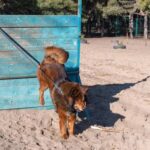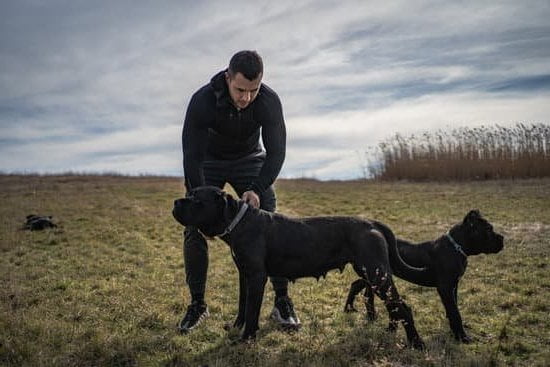Having a dog that can roam freely without the need for a leash is a dream for many pet owners. The freedom to explore, play, and enjoy outdoor activities together without being tethered can be incredibly rewarding. In this article, we will delve into the world of off-leash training, exploring the benefits it offers and how it can help build a stronger bond with your furry companion.
Off-leash training is not only about giving your dog more freedom; it is also essential for their safety. By teaching your dog to obey commands reliably without a leash, you can ensure they stay out of harm’s way in potentially dangerous situations. Additionally, off-leash training promotes better control over your dog’s behavior, allowing them to interact with other people and animals in a respectful manner.
Understanding your dog’s personality and breed is crucial when embarking on the journey of off-leash training. Different breeds have varying temperaments and instincts that may affect their ability to be trained off-leash. By recognizing these individual traits and challenges, you can tailor your training techniques accordingly to set your dog up for success.
In the following sections of this article, we will guide you through the process of off-leash training step-by-step. We will explore establishing basic obedience commands, creating a safe training environment, gradual progression and proofing techniques, recall training as the key to off-leash success, building trust with your canine companion, troubleshooting setbacks along the way, and ultimately embracing the joy of living an off-leash lifestyle.
So if you’re ready to experience the ultimate freedom with your four-legged friend, let’s dive into the wonderful world of off-leash training.
Understanding Your Dog’s Personality and Breed
Recognizing your dog’s unique personality and breed characteristics is essential when training them to be off-leash. Each dog breed has its own set of traits and tendencies that can play a significant role in determining the feasibility of off-leash training.
Different breeds have been bred for specific purposes, such as hunting, herding, guarding, or companionship. These purposes often translate into certain instincts and behaviors that may impact their ability to listen and respond effectively off-leash. For example, a herding dog like a Border Collie may have a strong instinct to chase or control movement, while a scent hound like a Beagle may be highly driven by their nose.
It is crucial to understand these inherent traits of your dog’s breed in order to tailor your training approach accordingly. Keep in mind that not all dogs will be suitable candidates for off-leash training due to their breed characteristics or individual temperament. In some cases, certain breeds may require more intensive or specialized training techniques.
To optimize the success of off-leash training, it is essential to identify the specific challenges that come with your dog’s personality and adapt your training techniques accordingly. Some common challenges include distraction-prone dogs, easily startled dogs, or those with high prey drive. By understanding these challenges, you can proactively address them and develop strategies to overcome them during the training process.
Table: Popular Dog Breeds for Off-Leash Training
| Breed | Traits |
|---|---|
| Border Collie | Highly intelligent, energetic, herding instincts |
| Golden Retriever | Friendly, obedient, eager-to-please |
| Australian Shepherd | Smart, active, strong herding and guarding instincts |
| Labrador Retriever | Friendly, trainable, obedient |
| Vizsla | Energetic, intelligent, highly trainable |
Understanding your dog’s personality and breed is an essential foundation for successful off-leash training. By recognizing their unique traits and tendencies, you can adapt your training techniques to overcome specific challenges and increase the likelihood of a strong and trusting off-leash bond with your furry friend.
Establishing Basic Obedience Commands
When training a dog to be off-leash, it is crucial to establish a foundation of basic obedience commands. These commands are the building blocks for a well-trained and reliable off-leash companion. Here are some essential commands to teach your dog:
- Sit: Teaching your dog to sit on command is important for their safety as well as controlling their behavior. Start by holding a treat near your dog’s nose and then slowly raise it above their head. As their head goes up, their bottom will naturally go down into a sitting position. Say the word “sit” as they sit, praise them, and give them the treat.
- Stay: The stay command teaches your dog to remain in one place until released. Begin by asking your dog to sit, then extend your hand in front of you like a stop sign and say “stay.” Take a step back, if they stay put, reward them with praise or a treat. Gradually increase the distance and duration of stay.
- Come: Recall is one of the most important commands when training your dog to be off-leash. Start by squatting down and enthusiastically calling your dog’s name followed by “come” while patting your leg or using an encouraging gesture. When they come to you, reward them with praise or treats. Make sure to practice this command in different environments and gradually introduce distractions.
- Leave It: This command is vital for keeping your dog safe from potentially dangerous objects or substances they may encounter during off-leash adventures. Hold out a low-value treat in one hand while saying “leave it.” By covering the treat with your hand, you are preventing access and teaching impulse control. Once they stop trying to get the treat, reward them with a higher-value treat and praise.
Consistency and positive reinforcement are key when teaching these commands. It is important to use reward-based methods, such as treats, praise, or playtime, to motivate your dog and reinforce their good behavior. Break the training sessions into short, frequent sessions rather than long ones to keep your dog engaged and prevent frustration.
By mastering these basic obedience commands, your dog will become more responsive and obedient overall. These commands lay the foundation for more advanced off-leash training and open up a world of possibilities for both you and your furry friend. Remember to practice patience and have fun with the training process as you build a stronger bond with your dog.
Creating a Safe Training Environment
Identifying Suitable Locations for Off-Leash Training
When it comes to off-leash training, choosing the right location is crucial for your dog’s safety and success. Start by finding an area that is secure and free from hazards.
A fenced yard or a designated dog park can be ideal options as they provide a controlled environment where you can focus on training without worrying about outside distractions or dangers. If you don’t have access to such spaces, consider finding open areas with minimal foot traffic, away from busy roads or crowded places.
Ensuring a Secure and Controlled Area
Before beginning off-leash training, take the time to secure the training area properly. Check the fences for any holes or gaps that your dog could escape through, ensuring that they are sturdy and tall enough to prevent jumping over. Be mindful of potential hazards within the training area, such as poisonous plants, sharp objects, or bodies of water that your dog may be tempted to explore.
Furthermore, it is essential to create a controlled environment during off-leash training sessions. Avoid letting your dog wander off into unknown territory until they have mastered basic commands and built trust in their recall abilities. Consider using long training leashes or lightweight drag lines as a safety measure initially. These tools allow you to maintain control while still giving your dog some freedom to roam around within a limited distance.
Utilizing Physical and Mental Barriers
To enhance safety during off-leash training sessions, both physical and mental barriers can be helpful tools. Utilize physical barriers such as baby gates or exercise pens to section off parts of your living space when practicing indoor obedience commands. This will provide boundaries for your dog’s movements and prevent any unsupervised mischief.
In addition to physical barriers, mental barriers can also play a significant role in maintaining control during off-leash training. Implement techniques like boundary training where you teach your dog to stay within a designated area using verbal cues like “boundary” or physical markers like cones. This mental boundary will help your dog understand their limits and resist the temptation to wander off.
By creating a safe training environment with appropriate boundaries, you are setting yourself and your dog up for success in off-leash training. Remember that consistency and patience are key during this process, allowing both you and your furry friend to enjoy the benefits of off-leash living.
Gradual Progression and Off-Leash Proofing
Once your dog has mastered the basic obedience commands and you have established a safe training environment, it’s time to start gradually progressing towards off-leash training. This section will provide guidance on how to expand your dog’s boundaries and proof their off-leash behavior in various environments.
1. Securely Fenced Area: Begin by practicing off-leash training in a securely fenced area, such as your backyard or a designated dog park. This will ensure that your dog cannot run away or get into any dangerous situations while you work on their recall and off-leash behavior.
2. Expanding Boundaries: As your dog becomes more reliable with their commands within the secure area, you can start expanding their boundaries slowly. Take them to larger parks or open spaces where they can explore but still remain under control. Gradually increase the distance between you and your dog while maintaining clear communication through commands.
3. Introducing Distractions: In order to proof your dog’s off-leash behavior, it is important to introduce distractions gradually. Start with mild distractions, such as toys or treats scattered around, and practice commanding your dog to ignore them and focus on you instead. As they become more proficient at ignoring distractions in controlled environments, move on to more challenging scenarios involving other animals or people.
4. Real-Life Scenarios: Train your dog in real-life scenarios such as busy sidewalks or parks where there are more distractions present. Practice recall exercises and reinforce the importance of listening to commands even in distracting environments. Be patient during this stage as it may take more time for your dog to respond consistently without a leash in these situations.
Remember, consistency is key when working towards off-leash training success. Practice regularly in different environments to continue reinforcing your dog’s reliability without a leash. Always reward and praise your dog for their good behavior, as positive reinforcement is a powerful tool in the training process.
If you encounter setbacks or difficulties, don’t hesitate to seek the help of a professional trainer who can provide additional guidance and support. With patience, dedication, and gradual progression, your dog will eventually be able to enjoy the freedom of off-leash living.
Sources:
- Source 1: “Off-Leash Dog Training: A Step-by-Step Guide” by Nicole Wilde
- Source 2: “The Off-Leash Dog: A Complete Guide to Training Your Dog to Obey Without a Leash” by Robin Kovary
Recall Training
Recall training is crucial when it comes to off-leash training for your dog. Having a reliable recall command ensures that your furry friend will come back to you when called, even in distracting or tempting environments. This section will explore the importance of recall training and provide effective techniques to teach this command.
To start with recall training, it is essential to select a high-value reward that motivates your dog. This could be their favorite treat or toy. By using positive reinforcement techniques, you can associate the recall command with something pleasurable for your dog.
For instance, whenever you call your dog’s name followed by the recall command, reward them immediately when they come to you. This helps in creating a positive association with the command and reinforces their understanding of what is expected from them.
Another technique for recall training is to gradually increase the distance between you and your dog. Begin by calling your dog from a short distance away and gradually increase the distance as they become more comfortable and proficient in responding to the command.
It is also important to practice recall training in various environments with different levels of distractions. Start in a quiet area without any distractions and then progress to busier places where there are other people, animals, or enticing smells.
One common challenge during recall training is distractions. Dogs are naturally curious creatures who may be easily tempted by sights, smells, or sounds in their surroundings. To overcome this challenge, it can be helpful to use long leashes or long-line training aids initially. This allows your dog some freedom while still giving you control over their movements until they have mastered the recall command consistently.
Overall, recall training serves as the key foundation for successful off-leash training with your dog. By using positive reinforcement techniques and gradually increasing the level of difficulty during practice sessions, you can strengthen their understanding of the recall command and ensure a stronger bond between you and your furry friend. Remember to be patient, consistent, and celebrate every successful recall as it brings you one step closer to enjoying the freedom of off-leash living with your dog.
| Technique | Description |
|---|---|
| Select a high-value reward | Choose a reward that motivates your dog and associate it with the recall command. |
| Increase distance gradually | Begins by calling your dog from a short distance and gradually increase the distance over time. |
| Practice in various environments | Start in quiet areas and progress to busier places with distractions to reinforce the recall command. |
| Use long leashes or long-line training aids | Give your dog some freedom while still having control during initial stages of recall training. |
Building Trust and Reinforcing Off-Leash Etiquette
One of the most important aspects of off-leash training is building trust between you and your dog. Trust is the foundation for a successful off-leash experience, as it allows your dog to feel secure and confident in following your commands. There are several exercises that can help strengthen the bond between you and your furry friend.
Firstly, engage in trust-building activities such as hand-feeding or playing interactive games together. Hand-feeding involves feeding your dog its meals by hand, allowing them to associate you with positive experiences. This can be particularly effective for dogs who may have had negative experiences in the past or are generally anxious.
In addition to hand-feeding, interactive games like hide-and-seek or treasure hunts can also help build trust. These games encourage your dog to rely on their sense of smell and problem-solving skills while reinforcing their bond with you. As your dog starts to trust you more, they will become more responsive to your commands even when off-leash.
Off-leash etiquette is another crucial aspect of training. It’s important to teach your dog proper social behavior around other dogs and people when off-leash. This includes not approaching or jumping on strangers without permission, as well as not approaching other dogs without proper introduction and consent from their owners.
To reinforce off-leash etiquette, incorporate impulse control exercises into your training routine. Teach your dog commands like “wait” or “leave it,” which help them understand boundaries and control their impulses. Practice these commands in various settings with different distractions to ensure that your dog consistently follows them.
Remember that training takes time, consistency, and patience. Set realistic expectations for yourself and your dog during this process. Every canine companion is unique, so progress may vary depending on temperament, breed, and individual quirks. Don’t hesitate to seek professional help if you encounter any challenges along the way.
By focusing on building trust and reinforcing off-leash etiquette, you can create a strong foundation for your dog’s successful off-leash training. The bond and communication between you and your furry friend will grow stronger, allowing for greater freedom and enjoyment during your adventures together. So don’t hesitate to embark on this journey and experience the joy of off-leash living with your dog.
Troubleshooting and Handling Setbacks
Common Setbacks during Off-Leash Training
During the process of training your dog to be off-leash, you may encounter a few setbacks along the way. It’s important to remember that setbacks are a normal part of any training process and can be addressed with patience and perseverance. Here are some common setbacks you might come across:
- Distractions: Dogs are naturally curious creatures, and it’s common for them to get easily distracted by sights, sounds, or scents in their environment. This can make it challenging for them to focus on your commands and stay engaged in training sessions.
- Fear or Lack of Confidence: Some dogs may experience fear or lack confidence when faced with new environments, people, or animals. This can make them hesitant to respond to commands or venture too far from their comfort zone. Building trust and providing positive reinforcement can help them overcome these fears and gain confidence.
- Lack of Focus: Dogs may sometimes struggle with maintaining focus during off-leash training, especially if they haven’t yet mastered basic obedience commands or if they’re easily excited by their surroundings. Consistency, patience, and utilizing appropriate rewards can help improve their focus over time.
Strategies to Overcome Setbacks
Overcoming setbacks requires understanding your dog’s individual needs and tailoring your approach accordingly. Here are some strategies that can help address common setbacks during off-leash training:
- Manage Distractions: Start by training your dog in an environment with minimal distractions before gradually introducing more challenging situations. Gradually increase the level of distraction as your dog becomes more proficient in responding to commands.
- Break Tasks into Smaller Steps: If your dog is struggling with a particular command or behavior, try breaking it down into smaller steps and rewarding each step along the way. This will make the task more manageable for your dog and increase the likelihood of success.
- Use Positive Reinforcement: Positive reinforcement, such as treats, praise, and playtime, can greatly enhance your dog’s motivation and willingness to learn. Rewarding desired behaviors will reinforce them and make them more likely to occur in the future.
- Seek Professional Help if Needed: If you’re facing persistent challenges or are unsure how to address a specific setback, consider seeking guidance from a professional dog trainer. They can provide expert advice and tailor training techniques based on your dog’s unique needs.
It’s important to remember that each dog is an individual, and training progress may vary. Patience, consistency, and understanding will go a long way in successfully addressing setbacks during off-leash training.
Embracing the Joy of Off-Leash Living
In conclusion, training your dog to be off-leash can bring a whole new level of joy and freedom to your lives. The benefits of off-leash training are numerous, from the safety of having a reliably obedient dog to the stronger bond you will develop through the training process. By understanding your dog’s personality and breed traits, you can tailor your training techniques to effectively teach them the necessary commands.
Establishing basic obedience commands is crucial for off-leash success. Through consistency and positive reinforcement techniques, you can ensure that your furry friend learns and obeys commands such as sit, stay, come, and leave it. Creating a safe training environment is equally important; identifying suitable locations and utilizing physical and mental barriers will prevent accidents or distractions.
Remember that off-leash training is a gradual process. Starting with a secure fenced area and gradually expanding boundaries will allow your dog to become comfortable in different environments. Recall training is key to off-leash success, so teaching a reliable recall command using high-value rewards and positive reinforcement techniques is essential. Building trust with your dog through trust-building exercises will strengthen your bond and reinforce proper off-leash etiquette.
While setbacks may occur during the training process, it is important to remain patient and seek professional help if needed. Troubleshooting common challenges like distractions or fear will help address setbacks effectively. Ultimately, embracing the joy of off-leash living is about enjoying the rewards it brings – the freedom to explore together and embark on unforgettable adventures with your four-legged companion.
Frequently Asked Questions
How long does it take to train a dog to stop pulling on leash?
The amount of time it takes to train a dog to stop pulling on leash can vary depending on several factors, including the dog’s breed, age, and previous training experiences. Additionally, the consistency and effectiveness of the training methods used can also influence how quickly a dog learns to stop pulling.
Generally, with regular practice and patient repetition of the desired behavior, it is possible to start seeing improvements within a few weeks. However, for some dogs with ingrained pulling habits or behavioral issues, it may take several months of consistent training to achieve reliable loose-leash walking.
Do dogs naturally stop pulling on leash?
Dogs do not naturally stop pulling on leash without proper training and guidance from their owners. Pulling on the leash is a behavior that comes instinctively to many dogs due to their natural inclination to explore their environment and lead ahead.
Additionally, some dogs may pull as they find it rewarding or they have not been taught an alternative behavior. Therefore, it is crucial for dog owners to actively teach their pets how to walk politely on a leash through positive reinforcement training techniques.
How do you stop an extreme leash pulling?
To address extreme leash pulling in dogs, it is important first to identify the underlying reason behind this behavior. It could be due to excitement, fear or anxiety, lack of exercise or mental stimulation, or even inadequate socialization. Once the potential triggers are identified, specific strategies can be implemented accordingly.
These may include desensitization and counterconditioning techniques to help the dog associate positive experiences with walking calmly on a leash. Additionally, using techniques such as redirecting attention with treats or toys during walks can help redirect their focus away from pulling. It is recommended to consult a professional dog trainer or behaviorist who can assess the situation and provide customized guidance based on the individual needs of the dog.

Welcome to the blog! I am a professional dog trainer and have been working with dogs for many years. In this blog, I will be discussing various topics related to dog training, including tips, tricks, and advice. I hope you find this information helpful and informative. Thanks for reading!





